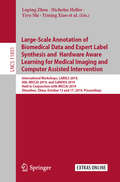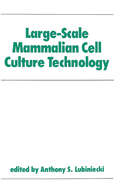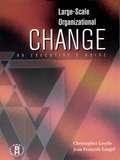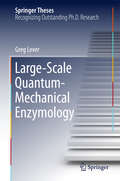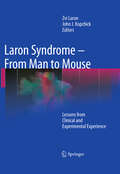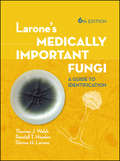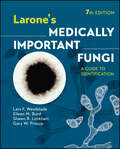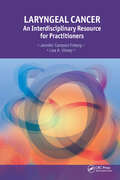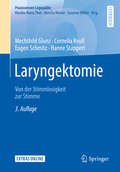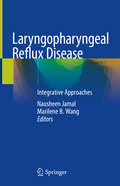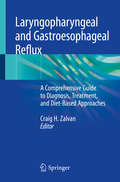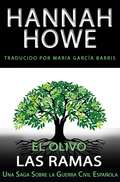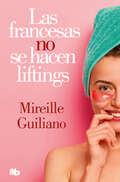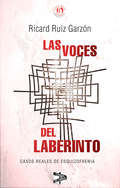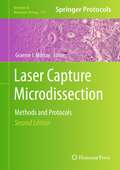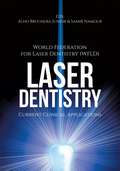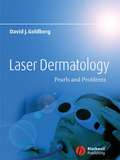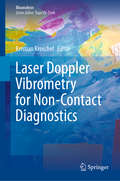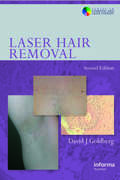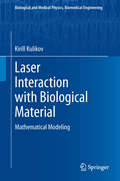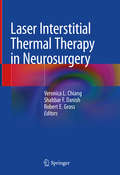- Table View
- List View
Large-Scale Annotation of Biomedical Data and Expert Label Synthesis and Hardware Aware Learning for Medical Imaging and Computer Assisted Intervention: International Workshops, LABELS 2019, HAL-MICCAI 2019, and CuRIOUS 2019, Held in Conjunction with MICCAI 2019, Shenzhen, China, October 13 and 17, 2019, Proceedings (Lecture Notes in Computer Science #11851)
by Emanuele Trucco Diana Mateus Veronika Cheplygina Yiming Xiao Hassan Rivaz Ingerid Reinertsen Matthieu Chabanas Raphael Sznitman Luping Zhou Yiyu Shi Nicholas Heller X. Sharon Hu Danny ChenThis book constitutes the refereed joint proceedings of the 4th International Workshop on Large-Scale Annotation of Biomedical Data and Expert Label Synthesis, LABELS 2019, the First International Workshop on Hardware Aware Learning for Medical Imaging and Computer Assisted Intervention, HAL-MICCAI 2019, and the Second International Workshop on Correction of Brainshift with Intra-Operative Ultrasound, CuRIOUS 2019, held in conjunction with the 22nd International Conference on Medical Imaging and Computer-Assisted Intervention, MICCAI 2019, in Shenzhen, China, in October 2019. The 8 papers presented at LABELS 2019, the 5 papers presented at HAL-MICCAI 2019, and the 3 papers presented at CuRIOUS 2019 were carefully reviewed and selected from numerous submissions. The LABELS papers present a variety of approaches for dealing with a limited number of labels, from semi-supervised learning to crowdsourcing. The HAL-MICCAI papers cover a wide set of hardware applications in medical problems, including medical image segmentation, electron tomography, pneumonia detection, etc. The CuRIOUS papers provide a snapshot of the current progress in the field through extended discussions and provide researchers an opportunity to characterize their image registration methods on newly released standardized datasets of iUS-guided brain tumor resection.
Large-Scale Mammalian Cell Culture Technology (Biotechnology And Bioprocessing Ser. #10)
by LubinieckiAn interdisciplinary approach, integrating biochemistry, biology, genetics, and engineering for the effective production of protein pharmaceuticals. The volume offers a biological perspective of large-scale animal cell culture and examines diverse processing strategies, process management, regulator
Large-Scale Organizational Change: An Executive's Guide
by Christopher Laszlo Jean Francois LaugelLarge Scale Organizational Change provides the principles by which large scale organizations reinvent themselves not once, but on an ongoing basis. Continual reinvention allows leading companies to learn, adapt, and innovate faster than competitors in complex and fast changing environments. These action principles are based on first-hand experience at the world's leading Fortune 500 companies using emergent models of living systems.The context for large scale organizations is one of information overload, complexity and constant change. This book reduces the sense of vulnerability felt by managers. It provides a guide to piloting change in ways that lead to constant renewal and a capacity to survive frequent and often brutal changes in the operating environment. It describes a leadership concerned with the capacity to learn, inflection points, emergent strategies, knowledge management, the ability to anticipate, and tapping into the distributed intelligence resident in the organization. Large Scale Organizational Change provides managers with a framework for making their organizations highly adaptive in the complex market systems in which they operate, thereby reducing or eliminating the need for periodic episodes of traumatic restructuring and sometimes fatal reengineering processes.
Large-Scale Quantum-Mechanical Enzymology
by Greg LeverThis work establishes linear-scaling density-functional theory (DFT) as a powerful tool for understanding enzyme catalysis, one that can complement quantum mechanics/molecular mechanics (QM/MM) and molecular dynamics simulations. The thesis reviews benchmark studies demonstrating techniques capable of simulating entire enzymes at the ab initio quantum-mechanical level of accuracy. DFT has transformed the physical sciences by allowing researchers to perform parameter-free quantum-mechanical calculations to predict a broad range of physical and chemical properties of materials. In principle, similar methods could be applied to biological problems. However, even the simplest biological systems contain many thousands of atoms and are characterized by extremely complex configuration spaces associated with a vast number of degrees of freedom. The development of linear-scaling density-functional codes makes biological molecules accessible to quantum-mechanical calculation, but has yet to resolve the complexity of the phase space. Furthermore, these calculations on systems containing up to 2,000 atoms can capture contributions to the energy that are not accounted for in QM/MM methods (for which the Nobel prize in Chemistry was awarded in 2013) and the results presented here reveal profound shortcomings in said methods.
Laron Syndrome - From Man to Mouse
by Zvi Laron J. KopchickLaron syndrome (LS), or primary growth hormone (GH) insensitivity, was first described in 1966. Since then, many patients worldwide have been diagnosed with LS, which involves defects in the GH receptor that cause combined congenital deficiency of GH and IGF-I activities. In this comprehensive book the authors draw upon 50 years of multidisciplinary clinical and investigative follow-up of the large Israeli cohort of LS patients. The genetic basis of the syndrome is fully considered, and all aspects of the pathophysiology of IGF-I deficiency are described. Data derived from the recently generated mouse model of LS are reviewed and compared with the human LS experience. Valuable advice is provided on treatment, and treatment effects, such as metabolic effects, adipose tissue alterations, and impact on aging, are fully explored. Together, this book condenses, consolidates, compares, and contrasts data derived from the human and mouse LS experiences and provides a unique resource for clinical and basic scientists to evaluate and compare IGF-I and GH actions.
Larone's Medically Important Fungi: A Guide to Identification (ASM Books)
by Randall T. Hayden Thomas J. Walsh Davise H. LaroneThe definitive guide for identifying fungi from clinical specimens Medically Important Fungi will expand your knowledge and support your work by: Providing detailed descriptions of the major mycoses as viewed in patients' specimens by direct microscopic examination of stained slides Offering a logical step-by-step process for identification of cultured organisms, utilizing detailed descriptions, images, pointers on organisms' similarities and distinctions, and selected references for further information Covering nearly 150 of the fungi most commonly encountered in the clinical mycology laboratory Presenting details on each organism's pathogenicity, growth characteristics, relevant biochemical reactions, and microscopic morphology, illustrated with photomicrographs, Dr. Larone's unique and elegant drawings, and color photos of colony morphology and various test results Explaining the current changes in fungal taxonomy and nomenclature that are due to information acquired through molecular taxonomic studies of evolutionary fungal relationships Providing basic information on molecular diagnostic methods, e.g., PCR amplification, nucleic acid sequencing, MALDI-TOF mass spectrometry, and other commercial platforms Including an extensive section of easy-to-follow lab protocols, a comprehensive list of media and stain procedures, guidance on collection and preparation of patient specimens, and an illustrated glossary With Larone's Medically Important Fungi: A Guide to Identification, both novices and experienced professionals in clinical microbiology laboratories can continue to confidently identify commonly encountered fungi.
Larone's Medically Important Fungi: A Guide to Identification (Asm Bks.)
by Gary W. Procop Lars F. Westblade Eileen M. Burd Shawn R. LockhartLarone’s MEDICALLY IMPORTANT FUNGI The definitive guide for identifying fungi from clinical specimens With a new team of authors, Larone’s Medically Important Fungi, Seventh Edition, continues the longstanding tradition of high-quality content to expand your knowledge and support your work in clinical mycology by: Providing detailed descriptions of the major mycoses as viewed in patients’ specimens by direct microscopic examination of stained slidesOffering a logical step-by-step process for identification of cultured organisms, utilizing detailed descriptions, images, pointers on organisms’ similarities and distinctions, and selected references for further informationCovering more than 150 of the fungi most commonly encountered in the clinical mycology laboratory, including new entries for Emergomyces, Metarhizium anisopliae, Rasamsonia argillacea, Rhinocladiella mackenziei, Schizophyllum commune, and Thermothelomyces thermophilusPresenting details on each organism’s pathogenicity, growth characteristics, relevant biochemical reactions, and microscopic morphology, illustrated with photomicrographs, unique and elegant drawings, and color photos of colony morphology and various test resultsExplaining changes in fungal taxonomy and nomenclature that are due to information acquired through molecular taxonomic studies of evolutionary fungal relationshipsProviding basic information on molecular diagnostic methods, e.g., nucleic acid amplification and sequencing, MALDI-TOF mass spectrometry, and other commercial platformsIncluding an extensive section of easy-to-follow lab protocols, a comprehensive list of media and stain procedures, guidance on collection and preparation of patient specimens, and an illustrated glossary With Larone’s Medically Important Fungi: A Guide to Identification, both novices and experienced professionals in clinical microbiology laboratories can confidently identify commonly encountered fungi.
Larsens Anästhesie und Intensivmedizin für die Fachpflege: Plus: kostenfreier Zugang zum E-Learning-Modul
by Reinhard Larsen Tobias Fink Tilmann Müller-WolffMit dem „Larsen“ haben Sie das Standard-Lehrbuch in der Hand, das Sie durch die Fachweiterbildung und in der Praxis begleitet! Alle Inhalte systematisch aufbereitet, verständlich und nachvollziehbar erklärt, mit zahlreichen Abbildungen und Tabellen ergänzt. Praxisnahe Tipps für den Umgang mit dem Patienten, aktuelle Literatur für Wissbegierige und ein übersichtliches Glossar machen das Werk besonders praxistauglich.Aus dem InhaltGrundlagen und Verfahren in der Anästhesie und Anästhesiepflege Postoperative VersorgungGrundlagen der Intensivmedizin und IntensivpflegeLunge, Atmung, Beatmung, WeaningHerz-Kreislauf-Funktion und ihre StörungenNiere, Wasser-Elektrolyt- und Säure-Basen-HaushaltSpezielle Intensivmedizin in den verschiedenen FachgebietenDie 10. Auflage, nun unter interprofessioneller Herausgeberschaft. Komplett aktualisiert und um folgende Themen erweitert: Anästhesie in der Gynäkologie und bei geriatrischen Patienten, innerklinische Reanimation, spezielle Intensivpflege, Intensivbehandlung der Covid-19-Krankheit. Ein Muss für alle Pflegekräfte auf Intensivstation oder in der Anästhesie, Fachweiterbildungsteilnehmer und Lehrkräfte. Auch für Ärzte zum Lernen und Lehren ein bewährtes Nachschlagewerk! Plus: kostenfreier Zugang zum E-Learning-Modul mit Fragen und Antworten!
Laryngeal Cancer: An Interdisciplinary Resource for Practitioners
by Jennifer Campion Friberg Lisa VinneyLaryngeal cancer is a complex medical condition, and its treatments, both surgical and nonsurgical, typically affect a variety of life functions. These complex consequences of laryngeal cancer necessitate that many different medical specialties work together as a cohesive, collaborative care team to support patients and their caregivers/families.Despite the interdisciplinary treatment that laryngeal cancer requires, many resources offer the perspective of only one specific profession. Laryngeal Cancer: An Interdisciplinary Resource for Practitioners caters to the team approach that is needed to provide patients with evidence-based treatment and maximize outcomes.To fill this need for an interdisciplinary text, Drs. Jennifer Campion Friberg and Lisa Vinney bring together a wide range of medical professionals to represent their unique perspectives on the treatment of patients with laryngeal cancer. Each chapter addresses a different critical aspect of the interdisciplinary care and how they impact the other aspects, written by experts in each field.Sample Chapters Include: Medical and Surgical Diagnosis Airway and Respiratory Challenges Nutrition and Swallowing Challenges Psychosocial Care of the Patient Bonus! A supplemental website is available for healthcare providers to share with their laryngeal cancer patients and their caregivers/families. This resource provides critical information about all aspects of their care and treatment, presented in a simple, digestible way for the layperson to understand.When the whole team of health care professionals involved in laryngeal cancer management understands the big picture of care, they can tailor individual treatment priorities to the needs of each unique patient and maximize quality of life. Because of this, Laryngeal Cancer: An Interdisciplinary Resource for Practitioners is designed to be a comprehensive guide for any professional involved in the many facets of interdisciplinary care for patients with laryngeal cancer.
Laryngektomie: Von der Stimmlosigkeit zur Stimme (Praxiswissen Logopädie)
by Mechthild Glunz Cornelia Reuß Eugen Schmitz Hanne StappertDas Lehr- und Fachbuch zur Stimmrehabilitation nach einer Kehlkopfresektion vermittelt einerseits die Grundlagen (Anatomie, Ätiologie, Klinik von Kehlkopftumoren, medizinische Therapie, prä- und postoperative Behandlung, Therapieaufbau in der Stimmrehabilitation), andererseits das notwendige Praxiswissen in Form von Therapiebausteinen. Für die 2. Auflage wurde u.a. ein Kapitel zur Umsetzung der Internationalen Klassifikation (ICF) und Informationen über pathogenetische Faktoren und Operationstechniken ergänzt. Arbeitsmaterialien sowie Video- und Audiobeispiele zu Behandlungsmaßnahmen sind im Internet als Download erhältlich.
Laryngopharyngeal Reflux Disease: Integrative Approaches
by Nausheen Jamal Marilene B. WangThis comprehensive text provides the reader with an in-depth understanding of laryngopharyngeal reflux (LPR), and presents a practical and readable evidence-based approach to the diagnosis and management of patients with this condition. It highlights options for management of those patients who fail to improve with traditional reflux treatment and assists in determining the next steps in the management of this population. Information is presented from an inter-disciplinary perspective, including input by otolaryngology, gastroenterology, speech pathology, and complementary/integrative medicine.The first section of the book is dedicated to understanding the fundamentals of laryngopharyngeal reflux as a condition. It begins with a review of the fundamental anatomy and pathophysiology of LPR and summarizes the landmark and most recent advances in the scientific understanding of this condition. Subsequent chapters delve into the typical symptoms and clinical presentations of patients, with information provided on cost-effective work-up strategies to confirm the diagnosis. The second section focuses on management of this condition. It begins with a thorough review of traditional medical management, including use of proton pump inhibitors, histamine receptor antagonists, neutralizing agents, low acid diet, alkalinizing agents, and alginates. Surgical management is reviewed as well, including partial and full fundoplication operations. It concludes with “non-traditional” treatment options for LPR, with chapters dedicated to voice therapy, probiotics, herbal therapies, and integrative East-West medicine approaches. Laryngopharyngeal Reflux Disease will be a definitive guide for otolaryngologists, gastroenterologists, speech pathologists, and general physicians with an interest in traditional and complementary/integrative treatments for patients with laryngopharyngeal reflux.
Laryngopharyngeal and Gastroesophageal Reflux: A Comprehensive Guide to Diagnosis, Treatment, and Diet-Based Approaches
by Craig H. ZalvanThis text comprehensively reviews the current state of the art in Laryngopharyngeal Reflux (LPR) together with a comprehensive explanation and description of the known gastroesophageal reflux (GERD) literature. With chapters written by experts from around the world, this text aims to deliver what is current in reflux recognition, diagnosis, reflux related complications, and the various treatment modalities. This is the first textbook to combine the most up to date knowledge of both LPR and GERD meant for both specialties and the general medicine population. Completely unique to the reflux literature is a section detailing the substantial benefits of a mostly plant based, Mediterranean style diet in the treatment of reflux disease. Encouraging patients to read and learn about diet and health is likely the most important step in improving their disease. The text provides direction to the caregiver on how to transition to a mostly plant-based diet. Review of myths, effects of diet in the setting of other disease states, and dietary consequences are explained. Guidelines on how to transition diet, dining out while maintaining a plant-based diet, and how to wean off medication, such as PPI, are also provided.Laryngopharyngeal and Gastroesophageal Reflux: A Comprehensive Guide to Diagnosis Treatment, and Diet-Based Approaches will provide the medical community with a resource to understand, teach, and provide the latest in LPR and GERD information to the caregiver and subsequently the patient.
Las Ramas: El Olivo
by Hannah HoweLa joven enfermera Heini Hopkins viaja a través de Francia hacia España donde espera descubrir el destino de su novio, Deiniol Price, voluntario en las Brigadas Internacionales. Espera ser enfermera de las tropas Legalistas que luchan contra el fascismo en la Guerra Civil española. En un viaje parecido, pero sin conexión alguna, la novelista Naomí Parker viaja a España donde pretende escribir notas de propaganda en favor de los fascistas. También desea encontrarse con el hombre de sus sueños, el apuesto piloto, Príncipe Nicolás Esteban. Mientas Naomí disfruta de la vida acomodada en España, Heini va a parar a la línea del frente donde atiende a un incontable número de heridos. Los Legalistas se preparan para el combate con palos en lugar de armas mientras los fascistas les bombardean desde aviones alemanes. En esas circunstancias tan desiguales, ¿cómo puede sobrevivir Deiniol? Además, ¿cómo puede Heini mantenerse fiel a sí misma entre todo ese caos? MIentras busca las respuestas, Heini aprende a conocerse as í misma así como duras lecciones sobre el amor y la guerra.
Las Vegas Night with Her Best Friend
by Tina BeckettIn Tina Beckett&’s latest Harlequin Medical Romance, one sizzling kiss in Las Vegas fires sparks into two doctors&’ friendship, and soon they start to question if just friends is what they really want… TAKING A GAMBLE…WITH THEIR FRIENDSHIP! Evie Milagre&’s last name might mean miracle, but the pulmonologist no longer believes in them. Not since her ex-husband cheated on her. Yet Evie&’s laser focus on work—and only work!—starts to waver when she&’s tasked with organizing her hospital&’s annual gala alongside best friend Dr. Max Hunt. He&’s always made it clear that they can be no more than friends—after a traumatic childhood, Max won&’t let himself entertain a long-term commitment. So why can&’t she forget that electrifying Las Vegas night when they broke all their rules…and kissed!From Harlequin Medical: Life and love in the world of modern medicine.
Las francesas no se hacen liftings
by Mireille GuilianoSecretos de belleza y estrategias para envejecer con buena actitud, alegría y sin cirugía. Mireille Guiliano comparte secretos de belleza y estrategias para envejecer con buena actitud y alegría, ofreciendo sus consejos y su humor al tiempo que revela los secretos mejor guardados por las francesas acerca de cómo tener un excelente aspecto y sentirse demaravilla. Encara todos los temas, desde las lociones y las cremas hasta las dietas, la amistad y el amor.Gracias a su característica combinación de ingenio, consejos prácticos y talento narrativo, Guiliano proporciona una encantadora mirada sobre la belleza y el arte de envejecer en nuestra época. Para cualquiera que alguna vez haya gastado el equivalente a una cuota de hipoteca en tratamientos antiedad, se haya vestido de manera inadecuada para sus años, haya aumentado demasiado de peso o accidentalmente haya olvidado cómocoquetear, he aquí una manera proactiva de seguir teniendo un aspecto excelente y encontrarse estupendamente sin declararse enquiebra o recurrir a la cirugía. Reseñas:«Como una estupenda amiga que comparte sus secretos, Mireille Guiliano divulga, anima e inspira. Y lo hace con alegría.»Pamela Druckerman, autora de Cómo ser una mamá cruasán. «Las francesas poseen un estilo y una confianza en sí mismas increíbles. Mireille Guiliano supone una inspiración y sus libros son de lectura imprescindible para cualquier mujerque quiera tener mejor aspecto y, en última instancia, sentirse más bella.»Bobbi Brown, maquilladora y autora de Bobbi Brown Make-Up Manual
Las normas de César Millán
by Melissa Jo Peltier César Millán¿Estás desesperado porque te sientes incapaz de adiestrar a tu perro sin ayuda? ¿O a pesar de que has cuidado su educación se muestra agresivo, frustrado, tiene algún tipo de obsesión o ha desarrollado algún miedo o fobia? Si te gusta El encantador de perros, te has convertido en El líder de la manada, si has aprendido a integrar a tu perro como Uno más de la familia y has resuelto la incógnita de ¿Cómo criar al perro perfecto?, estás de enhorabuena porque ahora tienes la esencia del método de César Millán en un decálogo de normas que te ayudarán a descubrir que el adiestramiento no es sólo una cuestión de obediencia, sino que es más bien una cuestión de equilibrio, de respeto y de armonía con tu mascota. Acompañado de las enseñanzas de grandes profesionales del mundo del adiestramiento canino, César Millán, que lleva vendidos más de un millón de ejemplares de sus anteriores obras, nos ofreceen Las normas de César Millán un libro ameno y sencillo, lleno de consejos prácticos y cuadros de ejercicios paso a paso, en el que nos cuenta por un lado cómo llegó a ser el encantador de perros más famoso de América y por otro nos muestra cuáles son las bases necesarias para conseguir que nuestro perro no sólo nos obedezca sin más sino que nos acompañe con serenidad a lo largo nuestra vida diaria. Gracias a este libro aprenderás:- las bases del adiestramiento- las recompensas y los castigos- el respeto por el instinto- las normas de César para adiestrar a perros y educar a personas- el valor de los pequeños logros en la educación de tu perro- el respeto hacia tu mascota- la importancia del equilibrio
Las voces del laberinto
by Ricard Ruiz GarzónEste libro da voz a quienes habitualmente no la tienen. A aquellos que, extraviados en el laberinto de la enfermedad mental, sufren el rechazo de una sociedad presuntamente cuerda. Basados en quince testimonios reales sobre el padecimiento de la esquizofrenia, los relatos recogidos en Las voces del laberinto transmiten el dolor, el desconcierto, la impotencia y también la esperanza de quienes buscan una salida a la encrucijada que ofusca su existencia. Más que un tratado de psiquiatría, un ensayo sociológico o un manual de autoayuda, Las voces del laberinto es una aproximación testimonial, una recreación de casos reales que privilegia el punto de vista de los enfermos para romper tópicos, ahuyentar prejuicios y contribuir a la destrucción del estigma que el mal llamado esquizofrénico padece aún en nuestra sociedad.
Laser Capture Microdissection
by Graeme I. MurrayLaser microdissection techniques have revolutionized the ability of researchers in general, and pathologists in particular, to carry out molecular analysis on specific types of normal and diseased cells and to fully utilize the power of current molecular technologies including PCR, microarrays, and proteomics. In second edition of Laser Capture Microdissection: Methods and Protocols, experts in the field provide the reader with practical advice on how to carry out tissue-based laser microdissection successfully in their own laboratory using the different laser microdissection systems that are available and to apply a wide range of molecular technologies. The individual chapters encompass detailed descriptions of the individual laser based micro-dissection systems. The downstream applications of the laser microdissected tissue described in the book include PCR in its many different forms as well as gene expression analysis including application to microarrays and proteomics. Written in the highly successful Methods in Molecular BiologyTM series format, chapters include introductions to their respective topics, lists of the necessary materials and reagents, step-by-step, readily reproducible laboratory protocols, and tips on troubleshooting and avoiding known pitfalls. Authoritative and cutting-edge, Laser Capture Microdissection: Methods and Protocols, Second Edition is an ideal resource for researchers striving to move forward our understanding of normal physiology and pathology.
Laser Dentistry: Current Clinical Applications
by WFLD World Federation for Laser DentistryLaser Dentistry: Current Clinical Applications by the World Federation for Laser Dentistry (WFLD) is a comprehensive guide the state of the art, principles and practices of laser dentistry. This collection of articles were compiled by Professor Aldo Brugnera Junior DDS, MS, PhD and Professor Samir Namour, DDS, MS, PhD, is written for all those interested in the clinical use of laser technology related to dentistry, research, development and biology, and medicine and surgery. Topics include: Laser, history and physics; Laser periodontics; Laser applications in implantology; Laser in oral soft tissue surgery; The laser management of oral leukoplakias; Treatment of bone necrosis caused by biphosphonates, Treatment of vascular malformations; The role of lasers in caries prevention; Dentinal adhesion and cavity preparation; The power of the bubble Erbium laser generated cavitation; Pre-emptive dental anaesthesia by Nd:YAG photobiomodulation; Non-invasive diagnostic methods using lasers; Clinical use of laser/LED phototherapies; Laser photobiomodulation (PBM) with low level laser therapy (LLLT) in esthetic dentistry; Laser phototherapy & oral mucositis; Lasers in dentin dehypersensitivity; Photobiomodulation therapy and dentoalveolar derived mesenchymal stem cells; Dental bleaching without gel; Hard tissue modification, cavity preparation and caries removal using erbium lasers; Laser safety; Optical fluorescence; World Federation for Laser Dentistry (WFLD) progress and history.
Laser Dermatology
by David J. GoldbergThis is the second edition of a well-received book that has been revised and updated to reflect the state of the art in laser and light source technology. After an initial chapter describing the latest understanding of laser physics and safety, subsequent chapters consider laser treatment of vascular lesions, laser treatment of pigmented lesions and tattoos, laser removal of unwanted hair, ablative and non-ablative fractional resurfacing, and use of laser treatment for medical purposes. The book is extremely practical and reader friendly. All chapters are very well illustrated, include quick and clear bullet points, and feature a homogeneous structure covering core concepts, currently available technologies, indications and contraindications, an example of a consent form, and the author's personal treatment approaches. The authors are without exception world experts in the field from North America or Europe.
Laser Dermatology: Pearls and Problems (Procedures In Cosmetic Dermatology Ser.)
by David J. GoldbergThe first all-inclusive text on the pitfalls, complications and controversies surrounding the use of lasers in dermatology and aesthetic medicine Each chapter starts off by highlighting the key points and essential concepts, followed by a review of the associated pearls and problems Provides the reader with tips on how to improve the safe and effective use of lasers Images focus on the pearls and problems Laser Dermatology: Pearls and Problems is different from other laser dermatology books. Each of the five chapters begins by highlighting key points and essential concepts, then focuses on the pearls and problems for each area – based on the author’s vast experience in the field of laser dermatology. Dr. Goldberg addresses: Vascular Lasers Laser Hair Removal Pigmented Lesions, Tattoos, and Disorders of Hypopigmentation Ablative Lasers and Devices Non-Ablative Photorejuvenation and Skin Remodeling Dr. Goldberg goes beyond the standard “before and after” approach to use actual images to demonstrate the pearls and pitfalls discussed in the text.
Laser Doppler Vibrometry for Non-Contact Diagnostics (Bioanalysis #9)
by Kristian KroschelThis book presents recent outcomes of the collaborative “Tricorder” project, which brings together partners from industry, research institutes and hospitals to deliver an easy contactless alternative for electrocardiograms (ECG).Featuring contributions investigating the possible applications of laser Doppler vibrometry (LDV) signals for the remote measurement of vital parameters of the heart, the book provides insights into the vision and the history of the "Tricorder" project and the basic differences between the vibrocardiograms and electrocardiograms. It also discusses topics such as signal processing, heartbeat measurement techniques, respiration frequency and oxygen saturation determination, with a particular focus on the diagnostic value of the method presented, e.g., diagnosis of atrial fibrillation and estimation of the oxygen saturation in premature infants. Further, the authors review the advantages and drawbacks of the new method and the specific fields of application.This book will appeal to researchers and industry leaders interested in laser remote sensing for medical applications as well as medical professionals curious about new healthcare technologies.
Laser Hair Removal (Series in Cosmetic and Laser Therapy)
by David J GoldbergThe author of the best-selling text on Laser Hair Removal now returns to the subject. The topic has moved on immensely in the period between editions: of course, there have been technological innovations with lasers themselves - and this text notes the implications of these - but the most important developments have been in the nuance
Laser Interaction with Biological Material
by Kirill KulikovThis book covers the principles of laser interaction with biological cells and tissues of varying degrees of organization. The problems of biomedical diagnostics are considered. Scattering of laser irradiation of blood cells is modeled for biological structures (dermis, epidermis, vascular plexus). An analytic theory is provided which is based on solving the wave equation for the electromagnetic field. It allows the accurate analysis of interference effects arising from the partial superposition of scattered waves. Treated topics of mathematical modeling are: optical characterization of biological tissue with large-scale and small-scale inhomogeneities in the layers, heating blood vessel under laser irradiation incident on the outer surface of the skin and thermo-chemical denaturation of biological structures at the example of human skin.
Laser Interstitial Thermal Therapy in Neurosurgery
by Veronica L. Chiang Shabbar F. Danish Robert E. GrossThis book serves as a foundation for MRI guided laser interstitial thermal therapy (LITT) across neurosurgical diseases. It provides state-of-the-art information on the latest indications and results for LITT in CNS applications, as well as prerequisite historical perspective and technical fundamentals. Written by experts in the field, the text reviews the historical development of LITT, the technical and technological components required to perform LITT, its indications and contraindications, areas that still require investigation, LITT complications, and challenges to starting up LITT within one’s practice. As early adopters of the technology, the authors provide sage advice that reflects the initial learning curves of many of the users. The book then concludes with a practical guide to starting up a LITT practice in the current medical socioeconomic environment. Laser Interstitial Thermal Therapy in Neurosurgery is a guide that will allow all neurosurgeons interested in LITT to successfully adopt the technology and incorporate its use seamlessly, safely and appropriately into their individual practices.
